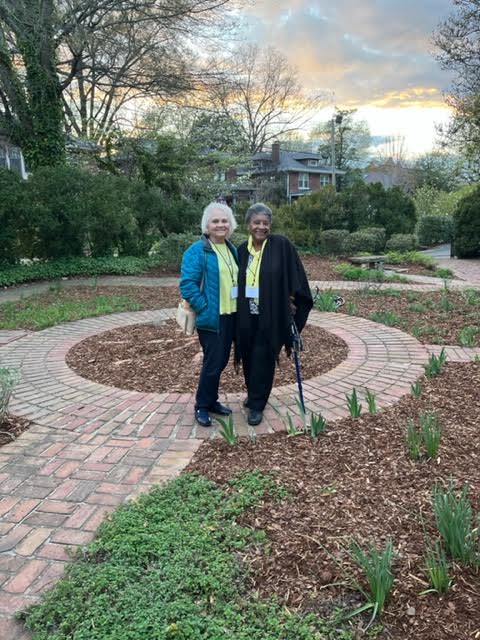Report on Alabama Historical Association, April 7-9, 2022
By Pam Thompson and Linda Joseph
Editor’s note: Linda Joseph and Pam Thompson attended the 74th annual meeting at Florence. Here is their report!
Upon arrival, we saw an African-American lady with a cane at the hotel door. She was alone and we asked her to ride with us for the tours that afternoon. That is how we came to spend the next two days with Louretta Wimberly of Selma who was one of the activists of the 1960’s Civil Rights era. She is a member of the Alabama Historical Commission and the Black Heritage Council. She has many stories to tell.
The first tour was of the Old Schoolhouse at the Village One development. There we learned the most interesting story of the development of technology to produce Amyl Nitrate for bombs in 1917 for WW I. With huge amounts of labor, a factory was built in less than a year, but the war ended. The factory was then repurposed for fertilizer production, making it possible for farmers to increase the crop yields to feed the world. The Village One were concrete block houses with tile roofs used for the Army officers and families. The neighborhood is still occupied although it is out past the industrial area of Sheffield. The school was a Sheffield city school until the 1990s but fell into disrepair. In 2018 a nonprofit was formed to preserve it as a community center. The roof has been repaired and events are being held but much is left to be done. Musicians have recorded in the auditorium space. We drove around the community, as it was sunny but cold and windy.
That evening, we went to Pope’s Tavern for the opening reception. We immediately saw two men across the street with signs that said Brian Murphy is a snake in the grass! We found out that Brian Murphy is the director of the museum—more on that later. The small house has a very nice museum of mainly Confederate memorabilia. We enjoyed refreshments and visited. Soon it got colder and dark, so we retired for the night.
The next day, Carrie Barske Crawford gave a talk about The Tennessee River in Northwest Alabama—there really are Shoals! The Muskogee lived there 12,000 years ago and we learned about the building of the Wilson Dam 1918-1926 for the Amyl Nitrate factory. Its completion became the beginning of the TVA, offering cheap electricity for the people of the South.
At the first concurrent session, I learned from Brian Murphy That Pope’s Tavern was never owned by anyone named Pope and was never a tavern! Hence the protesters were resisting changing that story which was first put forth by a newspaper man in the 1960s, probably to encourage preservation of the structure which does date from the 1830s.
Linda Joseph attended a session on the Bankheads of Alabama
Joseph A. Lee of the Black Heritage council spoke on the Cotton Kingdom: The Land of the Native Americans and the Labor of the Enslaved People enabled the wealth of the old South based on the cotton economy.
Eric Sipes and Linda Derry, Alabama Historical Commission spoke on their archaeological research on the first Alabama capitol at Cahawba. The site, developed by Gov. William Bibb, was on a Muskogee settlement location on the Alabama River. They discussed a familiar drawing from 1947 and their study of the plans made by Gov. Bibb for the building. The legislature gave him only $10,000 so he constructed a smaller temporary building. She offered a proposed drawing of what it would look like. The building was a brick, two-story but it apparently fell in while the legislature was in session in 1833. After that, the bricks were recycled, and the capitol was relocated to Tuscaloosa after Gov. Bibb died. She does not think the cupola exists, but there is one on a Loundesboro Church that purports to be from the first capitol. If it were, it would have been stored for over twenty years.
 After lunch, we took Miss Louretta to visit the Belle Mont Mansion. It was the home of Winston, the namesake of Winston County. We received a nice tour and met Miss Charlotte who is 100 and whose grandparents were enslaved on the 2,000-acre plantation. Then we went to the Rosenbaum Home in Muscle Shoals, built by Frank Lloyd Wright. It was a model home for affordable housing, so it was not large. The Rosenbaum family had four boys, so add-ons accommodated them. Mrs. Rosenbaum lived there until the 1990s. She oversaw its preservation as a museum, and it is quite a ‘time capsule’ of mid-century modern architecture.
After lunch, we took Miss Louretta to visit the Belle Mont Mansion. It was the home of Winston, the namesake of Winston County. We received a nice tour and met Miss Charlotte who is 100 and whose grandparents were enslaved on the 2,000-acre plantation. Then we went to the Rosenbaum Home in Muscle Shoals, built by Frank Lloyd Wright. It was a model home for affordable housing, so it was not large. The Rosenbaum family had four boys, so add-ons accommodated them. Mrs. Rosenbaum lived there until the 1990s. She oversaw its preservation as a museum, and it is quite a ‘time capsule’ of mid-century modern architecture.
Due to the continuing cold and wind, we drove through the University of North Alabama campus and over the Wilson Dam, through the TVA reservation and back to the hotel.
Awards were given at the banquet that evening. Dr. Don Noble, Professor Emeritus, University of Alabama, who is the commentator for the APTN series Bookmark spoke about “fifty years of Alabama Literature”. He had lively stories of the various authors he has interviewed.
Saturday morning in the business session, the officers reported. Scotty Kirkland, chair of the Marker Committee reported that six new markers are being placed this spring. One is at Arlington in Birmingham, describing the experience of the enslaved people who lived there. Applications for markers are available on the AHA website. (We should think about applying for some!)
Dr. Diedre Dees, Archivist for the Poarch band of Creek Indians, gave a presentation about the current tribes represented in the state. The Alabama Indian Affairs Commission has resources online.
In the breakout session, we heard Monica Tapper of Wallace Community College speak about Bossy O’Brien Hundley who was active in the state efforts for women’s suffrage 1913-1915. She was very interesting. Our March speaker for the HHS General Meeting, Dr. Marlene Rikard, mentioned Bossy and supplemented her topic on Alabama suffragettes.
At lunch, outgoing President Ben Severance spoke about the numbers of men from Alabama who served, killed, or wounded in the Civil War. He cited several sources including historian Leah Rawls Atkins, HHS Member. We enjoyed seeing familiar faces such as Dr. Wayne Flynt. He has a memoir out, which Pam bought and had signed. We also spoke with Marlene Rikard and Liz Wells (current and past members of the HHS.)

